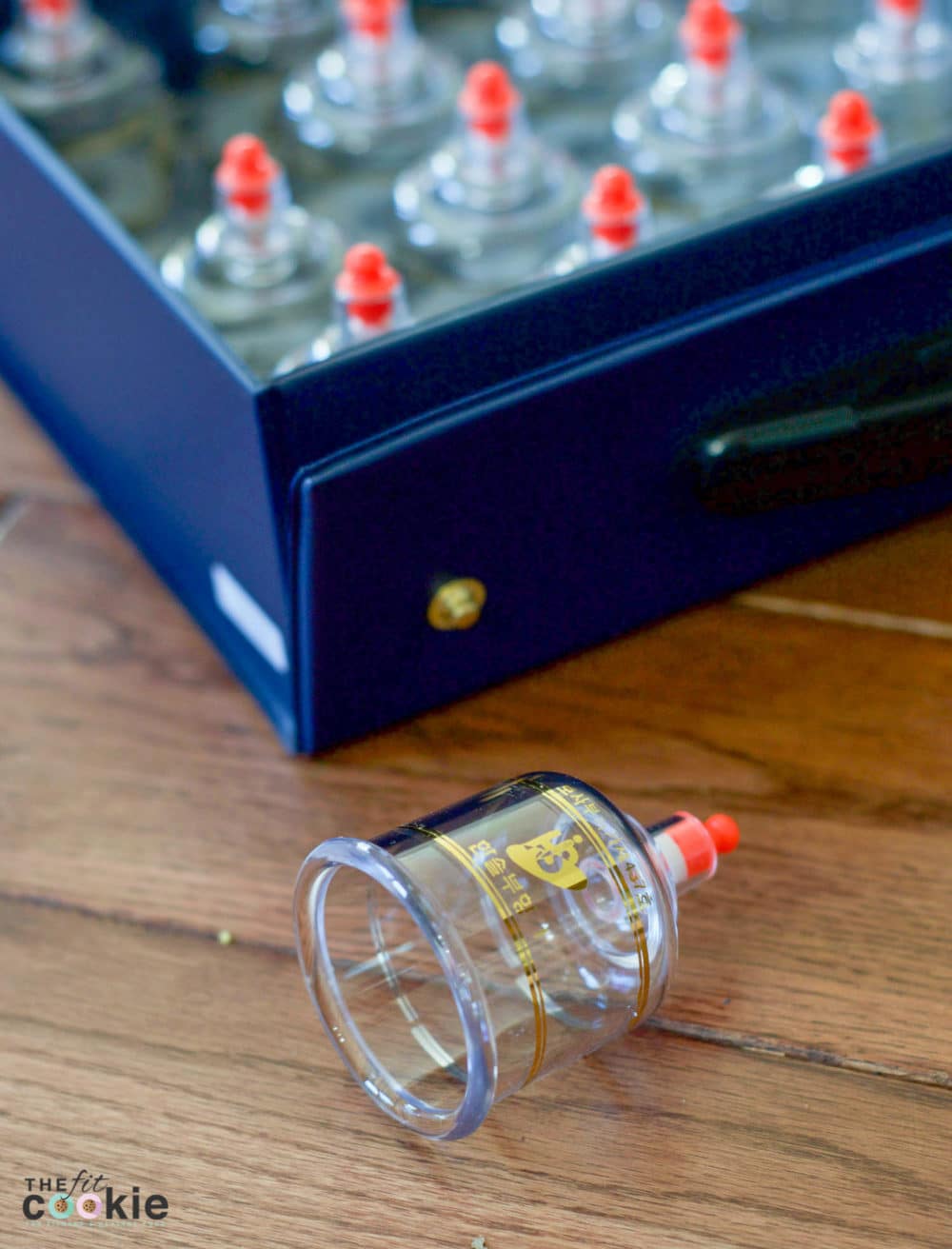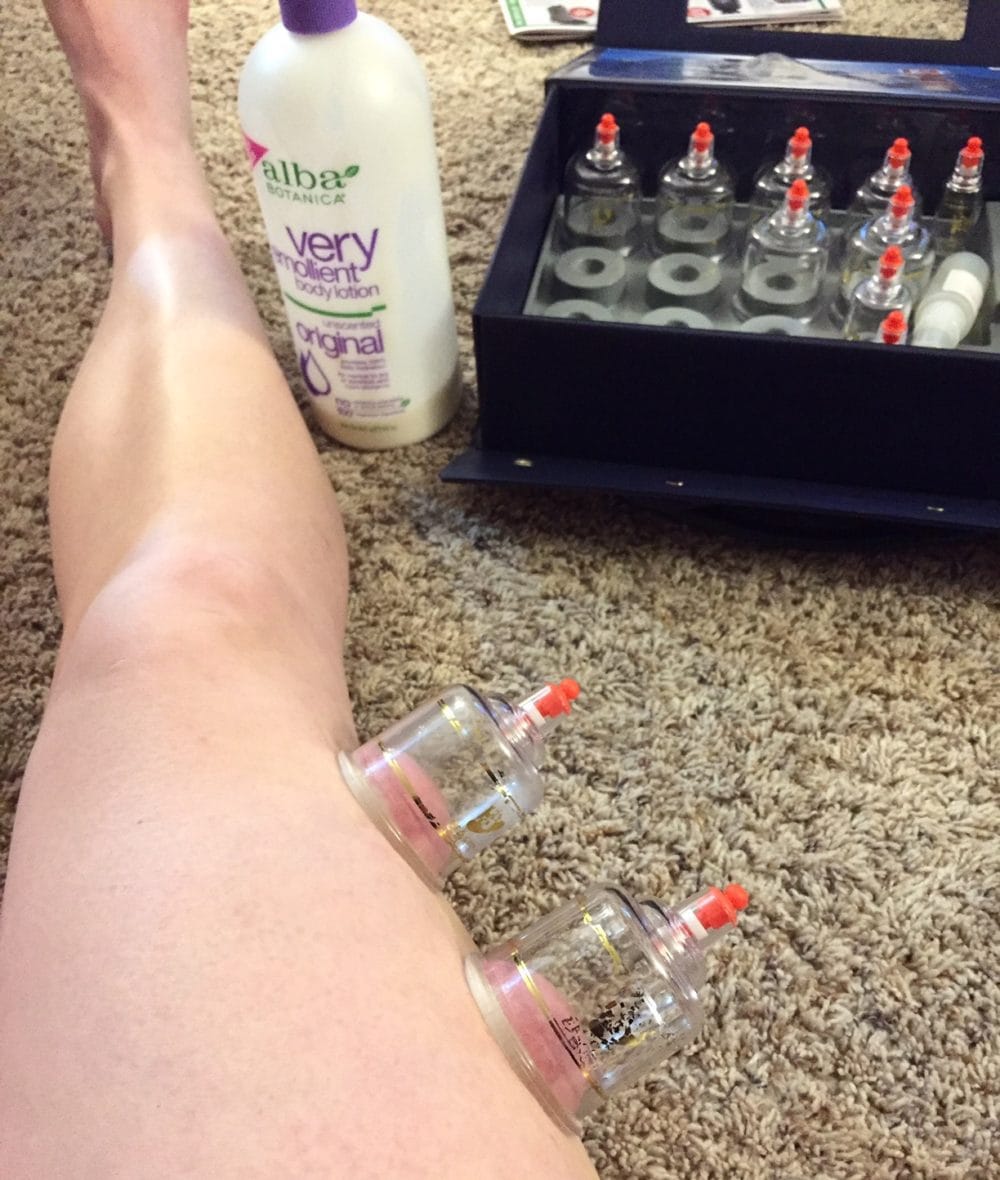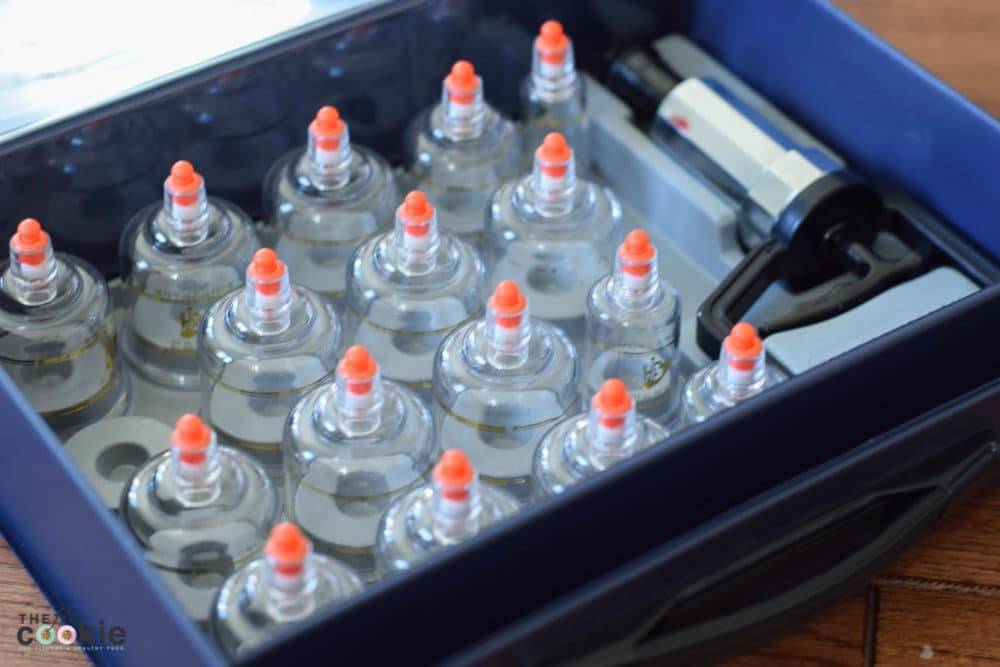Curious about cupping therapy? If you follow fitness trends, cupping might be something you have heard about. But cupping therapy is more than just a trend: it’s an ancient alternative medicine technique that is making a comeback as a fitness recovery tool

Being hurt sucks. If you are an active individual, you more than likely have had some injury during your fitness journey. Even though I don’t really consider myself someone who overdoes it with fitness, or an endurance athlete, I have battled tendinitis quite a bit over the years.

Unfortunately I am still struggling with tendinitis in the outside of my right knee which has been off and on for the past 3 years. I really want to kick it for good! Foam rolling, stretching, and cupping are regular parts of my fitness routine now, and they help a bunch.
The first time I had any cupping done was last year when I went to a new physical therapist. I had been to plenty of PTs before, but no one had ever done cupping on me. Even though I’m still dealing with tendinitis in my knee (mostly from squats and lunges unfortunately), cupping has made such a big difference in my tendinitis issues.
Most of this info is stuff that I have learned from my physical therapist, found through research, and discovered what has worked for me. This is not medical advice, and I am not a physical therapist. If you’re not sure if this is going to work for you, talk to a doctor or physical therapist first.
I created a Facebook live video about cupping, check it out!
Benefits of Cupping
Cupping began as an ancient Chinese alternative medicine technique, traditionally with glass cups, but in recent times has evolved into a physical therapy modality and deep tissue massage technique. I have only ever had it used in the physical therapy capacity, so that’s what I know and will share about mostly.
When cupping is used for physical therapy, it works through myofascial decompression. When we foam roll, that is a type of myofascial release through compression, similar to how massage works. Cupping works in a different way by lifting or decompression versus compression.
Sometimes when we get injured or we build up scar tissue from heavy exercise, our tissues create adhesions and can begin to stick or “glue” together and become less flexible. While targeted compression (through massage or foam rolling) helps to break up scar tissue adhesions, cupping releases scar tissue adhesions by creating space and lifting tissues a bit.
Cupping can help break up scar tissue and adhesions on muscles and connective tissue, and it can help move blood and lymph to the area to speed healing.
While the risks with cupping are generally small, do avoid cupping if you have bleeding disorders or are on medications or blood thinners. Always talk to a doctor before starting anything new like this!

There are different types of cupping therapy: wet cupping (where cuts are made in the skin, ouch!), fire cupping (using glass cups with fire), and soma cupping (using soft pliable plastic cups). My PT and I both use the hard plastic cups and a suction gun, and this has worked really well. I have a set of regular cups and curved cups that can be used for the side of joints (like knees).
The plastic cups with a suction gun like I have are very safe to use, wet cupping and fire cupping need to be done by a trained practitioner.
My PT recommended that I get a set of cups for home that I could do some of this on my own, and I bought a set on Amazon for maybe $36 and I have been cupping at home several times a week since then. It has become an integral part of my fitness and recovery routine!
Cupping Therapy Tips
- Do start out small, with small amounts of suction and shorter amounts of time to allow your body to acclimate. If you have very tight muscles and you put too much suction on at first, it can make your muscles tender
- Don’t use cups right on joints or bony areas (unless you have a curved cup)
- Do use massage cream, oil, or lotion when cupping
- Bruising is normal. Some people will bruise much easier than others, and some areas of your body will bruise easier than other parts of your body. That’s normal and okay. For me, my legs rarely get lasting bruises, but my back gets longer lasting bruises
- Don’t cup around the abdominal area unless directed to do so by a doctor or physical therapist
- Do cup several times a week as a part of your recovery routine (along with foam rolling and stretching) if you tend to get tendinitis easily
- Don’t cup around the femoral artery
- If you have bleeding disorders or are on blood thinners, consult a physician or physical therapist about the safety of cupping for you

Cupping Therapy Techniques
Even with one type of cup, there are different ways to use them and different techniques:
- Stationary cupping: the cup is placed over trigger points and left there for a few minutes. Beginners can start with a couple minutes and build up to doing 10 minutes at a time
- Moving the cup (“gliding cupping”): Once a bit of suction is placed on the cup, the cup is then moved around the area of interest. This can be pretty intense and painful at times, so build up to this! If you plan on moving the cup, don’t add as much suction and you must have a lotion or oil of some kind on your skin
- Stationary cup but moving the body: in this method, the cup is placed on a trigger point and then the person moves their body rather than moving the cup. For example, when I use this on my IT bands, I move my leg around a bit. This helps to release fascia in some different planes of movement
- Cupping muscles in a stretched position: I use this method on my husband’s back sometimes and it works well if you want to progress from regular stationary cupping. Simply find a place where you can hold a comfortable stretch and apply the cups to the stretched muscle. For example, you can move into child’s pose stretch then apply the cups to the back muscles. Or use the cups on your inner thigh muscles during a supported and seated butterfly stretch.

I personally find physical therapy, cupping, needling, myofascial release, and those sorts of things to be super fascinating! I’m always curious about how the body works. If you want to read up some more about cupping, here are some more useful articles:
- WebMD – What is Cupping Therapy?
- MindBodyGreen – 3 Reasons Everyone Should Try Cupping
- Dr. Axe – Cupping Therapy: Alternative Medicine for Pain, Immunity & Digestion
- Time – What is Cupping?
- Pacific College of Oriental Medicine: The Many Benefits of Chinese Cupping
Videos about cupping and techniques:
Disclaimer: this information is intended to be informational only and is not intended to replace the advice of your qualified healthcare professional.

Sarah Jane Parker is the founder, recipe creator, and photographer behind The Fit Cookie. She’s a food allergy mom and healthy living blogger based in Wyoming. Sarah is also an ACSM Certified Personal Trainer, ACE Certified Health Coach, Revolution Running certified running coach, and an ACE Certified Fitness Nutrition Specialist

I have been planning to try the suction cupping therapy because I heard that this is great in terms of relieving pain. It’s interesting to learn that cupping works by breaking up the tissue. I’m glad you shared this because I never knew that small suctions are better within the start of therapy because this will allow the body to acclimate.
Glad to be of help Rachel!
I have long been wanting to try cupping, I am just a bit tentative. Your article is really very informative. Thanks!
Thanks! If you have any health conditions, make sure to check with a doctor or physical therapist before adding cupping to your routine.
Nice post. I tried cupping before and it was really relaxing. You will feel rejuvenated after the session.
This is great and relaxing. Although, it doesn’t look good because my back looks like it’s being punched a lot of times.
Is it okay to use an ordinary glass cup when doing this?
Hi Francis, are you referring to a regular drinking glass? Those won’t work in this case since there is no way to add suction to the cup unless you were doing fire cupping (which I would not recommend since it is risky if you’re not professionally trained to do that). These sorts of plastic cupping sets or even silicone cupping sets are available online so they are generally easy to get. I hope that helps!
I’ve been wanting to try cupping for so long. I enjoyed discovering more about it by reading this!
You should definitely try cupping! It is great for fitness recovery
Really informative post! I’ve always wanted to learn more about cupping ever since I saw it in the Olympics. Seems to be really popular.
It has become pretty popular lately, it’s a great tool!
I find it interesting that it can help break down scar tissue – perhaps I should do some cupping on my stomach!
I would definitely see a physical therapist about cupping areas in the stomach. Our PT has done cupping on surgical scars for my husband on his stomach, but she said to generally avoid that area without supervision. But if you get a PT to do it, it might be helpful for you!
So interesting! I, too, saw this for the first time with all the Olympians with the circle marks!
It will make some funny looking marks (they look like hickeys!) but cupping is such a good way to recover from workouts. You should check it out!
I was amazed by how many athletes were doing the cupping thing during the Olympics! Wasn’t it Madonna who made it a big thing a few years ago? I find it intriguing–anything to help stave off injury, right?
I don’t really follow Madonna much so I can’t remember if she did or not, but I do remember that cupping was used by the PTs during the olympics! My PT has used it for years with her patients and swears by it. It has helped me a bunch!